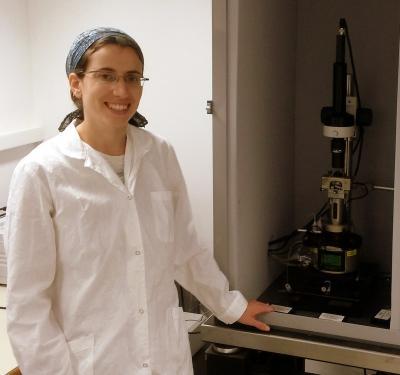The biggest mystery in the mid-east is why countries of one religion won't put the country of another religion on any geographical maps in any of its schools, but the second biggest mystery is why many of the oldest parts of Jerusalem's Western Wall look like they could have been placed yesterday.
The Western Wall is a remnant of the ancient wall that surrounded the courtyard of the Jewish Temple in Jerusalem. It is located in Jerusalem's Old City at the foot of the Temple Mount.
Some of its stones are extremely eroded, that is why people can place prayer notes in the wall's cracks and crevices, but other parts are something of an engineering mystery. Engineers would rather have concern about structural stability due to erosion than something unexplained that could go nonlinear at any time.
To calculate why the Western Wall erodes so different, or hardly at all in spots, researchers analyzed the limestone using a laser scan.

Jerusalem limestone is made up of tiny crystals. Photo: Dr. Simon Emmanuel, Hebrew University
The study found that stones made up of relatively large crystals were resistant to wear, so that they were almost unchanged in the 2,000 years since they were originally put in place. By contrast, limestone with very small crystals (about one thousandth of a millimeter in size) eroded far more quickly.
In some cases, extreme erosion rates in fine-grained micritic limestone blocks were up to 100 times faster than the average rates estimated for the coarse-grained limestone blocks. In some places these stones had receded by tens of centimeters, potentially weakening the overall structure.
The researchers are Dr. Simon Emmanuel, Senior Lecturer in Environmental Water Technology, and PhD student Yael Levenson, of the Hebrew University's Institute of Earth Sciences.
To understand what causes the two types of rock to behave differently, the researchers collected samples from ancient quarries thought to have supplied the stones for the Second Temple. Using a powerful atomic force microscope, they were able to see how the rocks disintegrated when they came into contact with water. During the experiments on rocks made up of small crystals, tiny particles rapidly detached from the surface of the rock. These experiments simulated the way in which rain water interacts with limestone in nature.

Part of the Western Wall shows highly eroded blocks alongside well preserved stones. Photo: Dr. Simon Emmanuel, Hebrew University
Observed for the first time in Dr Emmanuel's lab, this process of accelerated erosion can explain why some rocks are more weathered than others. While mechanical weathering is thought to act on blocks and chips of rock at the visible outcrop scale, the researchers showed for the first time that chemo-mechanical erosion extends down to the tiny micron scale. The findings could have important implications for regional and global carbonate weathering.
According to Emmanuel, "Understanding such weathering processes could help guide the development of effective preservation techniques. For example, it may be possible to develop materials that slow the rate of erosion by binding the tiny crystals in the rock together. Advanced engineering techniques like this should assist efforts to protect not only the Western Wall, but other cultural heritage sites in Israel and around the world."

Researcher Yael Levenson with the atomic force microscope in Hebrew University Earth Sciences lab. Photo: Hebrew University




Comments